by George Bryce, Life Member of the Society
MHS Transactions, Series 1, No. 46, Read 13 February 1894
|
The Historical Society, at its annual meeting in the City Council Chamber, was greeted by a large attendance of ladies and gentlemen. In addition to the other business of the evening the Rev. Dr. Bryce read the following interesting paper, for which, on the motion of Rev. Prof. Hart, seconded by Mr. John Macbeth, he was given a hearty vote of thanks:
Mr. Chairman, Ladies and Gentlemen. Few of the citizens of the Winnipeg of today - the third commercial city of the Dominion - know the days of its small beginnings. The writer, now in the twenty-third year of his residence in Winnipeg recurs with pleasure to the early days, and desires to picture the features of that humble but interesting period. Though the village of Winnipeg had an existence before the Riel rebellion of 1869-70, it was after that time that it came into note, and from that time that its influence began. The present paper is a record of beginnings, and so will not pass the close of 1873, the time of the incorporation of the city of the prairies.
The old Hudson's Bay company centre had of course been Fort Garry, on the banks of the Assiniboine. Here had centred for about half a century the trade of the Northwest. Here also was the headquarters of government, law, society and old association. From any part of the settlement on a pleasant autumn day or during a mild spell in winter, Scotch or French half-breed, Selkirk settler or retired Hudson's Bay company officer or servant delighted to journey to relieve the monotony of existence, and partake of the inspiration of social life. Five hundred acres about the fort, since known as the Hudson's Bay Reserve, afforded ample camping space for the plain traders, who came from the west to trade. Of them a former resident of Winnipeg has said : "These wild children of the prairie were won't to make their presence known in our midst, for with drinking, gambling, fighting, dancing, laughing talking, swearing, horse-racing, trading, and singing, they made a perfect Babel of the place."
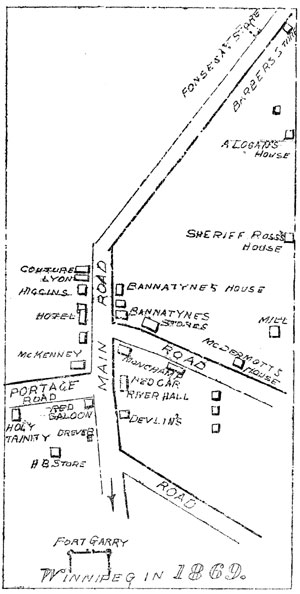
Map of Winnipeg in 1869
North of the reserve, beyond Notre Dame street, began in pre-Winnipeg days the strips of land of the settlers, with narrow frontage on the river, but running out for two miles upon the prairie. Here the first families of Winnipeg had their abode. First, claiming descent from Brian Boru, was Andrew McDermott, a sturdy Irishman, who had come by way of Hudson Bay in Lord Selkirk's first ship. He was a merchant, farmer, horse trader and cattle dealer. Of this man, who was well known to the writer as a perfect mine of information, Sheriff Ross said in 1886, "He engrossed the freighting business, acted as the company's right-hand man in all contracts and public undertakings, speculated in houses and lands, built mills, encouraged manufactures, and lately commenced forming a little colony, of which he is himself the head." McDermott avenue marks the estate and commemorates the name of this bustling leader of the olden time. North of Andrew McDermott was his son-in law A. G. B. Bannatyne, one of the kindest and best of the men of the former day. A leading merchant, a prominent man in public, social and church life, many a needy immigrant had reason to be grateful to him for favors bestowed. Bannatyne Avenue marks the Bannatyne estate.
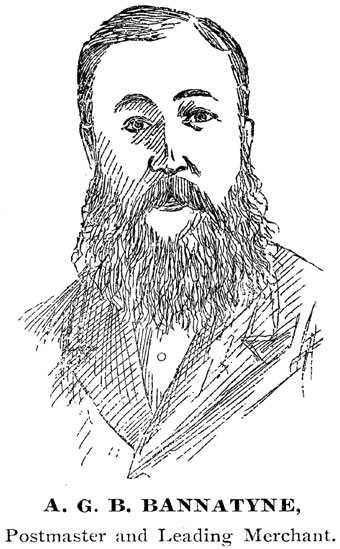
Andrew Graham Ballenden Bannatyne
Next along the river were the Bosses. Head of the family was the sheriff who, as long ago as 1825, came from British Columbia, with his Indian wife, the daughter of a chief of the Okanagans. William, James and Ross avenues commemorate this very influential family, whose home of Colony Gardens was a centre of hospitality in Red River days. North of the Ross abode was that of the Logans. This was the site of Fort Douglas, Lord Selkirk's headquarters; but old Robert Logan had purchased it. The present residence of Alexander Logan, formerly mayor of the city, is in the neighborhood of the old fort. Logan Avenue is a memorial of this well known family. As beyond this estate lay the Point Douglas common, these four families maybe said to have the pre eminence as our F. F. W's.
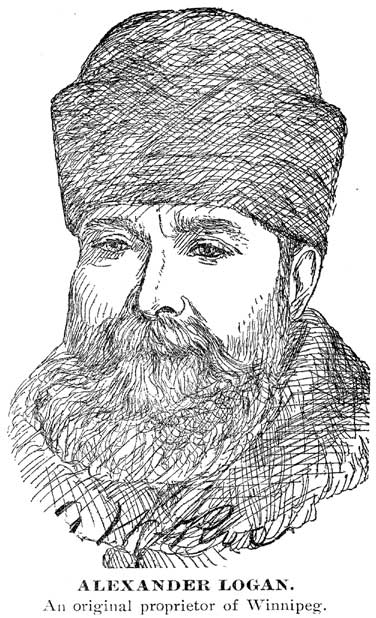
The investigation of Hudson's Bay company affairs by the Imperial Parliament in 1857, and the expedition sent by Canada under Dawson and Hind to explore the Northwest, led to a slaw, but decided movement of outsiders to the hitherto sealed and unknown territories of the Hudson's Bay company. The prophecy of a city at the junction of the Red and Assiniboine rivers was made at this early date. There was great unwillingness on the part of the settlers to leave the banks of the rivers, but in 1862 the first house in the village of Winnipeg was erected by McKenny & Co. Connected with this enterprise was Dr. Schultz, who had come to Red River in 1860. This house, which until two or three years ago stood at the corner of Main street and Portage avenue, was on the site now occupied by the handsome building of the Western Canada Loan and Savings company. This was then a swampy corner, but, by degrees a few buildings grew up, and the outline of our beautiful Main street of to-day began to be dimly seen. Once begun, the movement to build up a town led to division, and in 1871 a number of houses were built on Main street opposite Point Douglas, now a short distance on this side of the C. P. R. station. Thus there were three points, Fort Garry, Winnipeg and Point Douglas. three ganglia or centres placed alone Main street, and in their interests they were very far from responding to the same sympathetic throb.
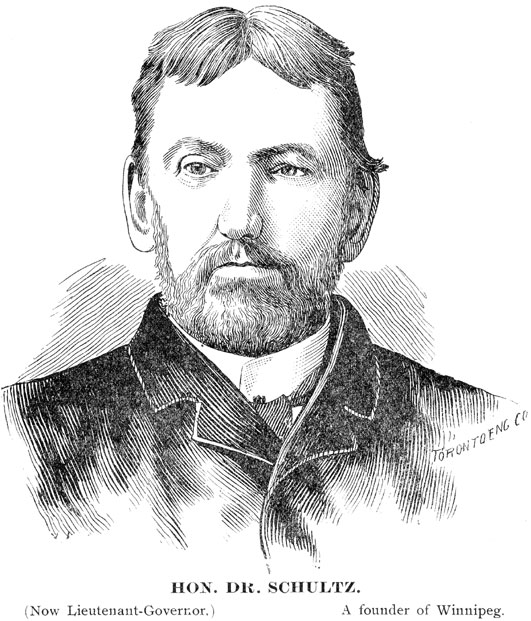
The buildings, as they stood in 1870, may be easily mentioned, and the merchants of Main street have been called by a writer of that' time the "original founders of Winnipeg." First there was the Red river hall building erected by Andrew McDermott, immediately south of the present Merchants' bank, a long building with several shops beneath, and a hall and several rooms above. The writer performed a marriage in the upper part of this building. This erection was burnt down in the early days. Mr. Bannatyne had two buildings on the corner of Main and Lombard streets. Farther up the street on the corner of Main and Water streets, Dr. Schultz erected the brick block, a part of which still remains. Messrs. Lyon, Higgins and Gingras had occupied buildings further north on Main street, and Messrs. Fonseca, Barber and Hon. John Sutherland were the promoters of Point Douglas. To the list of founders may he added Wm. Drever, who had built a house near the southwest corner of Main street and Portage avenue. This became a fashionable headquarters known as the "Munro boarding house," in which the writer passed a winter. West of the Drever house, near the line of the present Fort street, was a branch store of the Hudson's Bay company used during the winter of 1871 by the late Gilbert McMicken as land office and dominion police headquarters. To the list of merchants of the earliest time may be added the names of H. S. Donaldson, R. Patterson, J. H. Ashdown, Alexander Begg and Archibald Wright.
Early in October, 1871, the writer remembers arriving in Winnipeg in the stage by which at that time, at a distance of 100 miles, the railway in Minnesota was reached. Our company alighted in front of the chief hotel of Winnipeg, on the west side of Main street, immediately north of the McIntyre block. The writer had not expected to see in Winnipeg a beautiful or entrancing spot, but the sight of the western hamlet on that clear autumn evening was a little more disappointing even than the picture imagined. A street with a few irregular buildings, some of them log, with not a sidewalk, unless it were a log with a slanting surface requiring in muddy weather the skill of a Blondin to walk it, and the two story yellow stopping place with its dim and smoky lights! Such was the Winnipeg of that day; such was the Davis hotel, its chief hostelry. At that time there was a large influx of Canadians. The hotel during that week had been giving 330 meals a day, and even sleeping room on the floor could not be had. With a companion who knew the way, finding no room in the inn the journey was made by the writer to Kildonan, and the first night in Manitoba was spent in the hospitable manse of the Scotch parish.
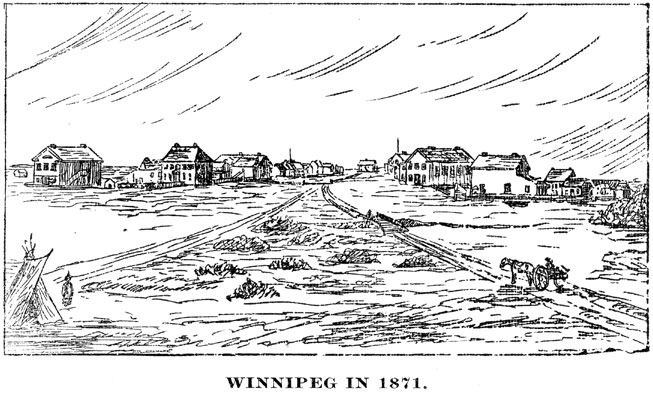
Winnipeg in 1871
In the early days Mr. A. G. B. Bannatyne was the postmaster. The first building entirely devoted to the purposes of the post office was used in 1870, and was on Lombard street, which was formerly called Post Office street. It was a log building and was situated nearly opposite the Hotel du Canada. It is recorded as an event of considerable importance that in June, '71, the postmaster "had boxes arranged in the post office, for the use of merchants and others," and the name of the carpenter who accomplished this feat of skill is held up for joyful remembrance. The carrying of the mail was undertaken in 1871 by an American stage company. The stage arrived for the first time on the 11th of September of that year. The arrival of the stage was a great event. One had the feeling that it was something like the clouds opening and letting in a rift of light. Sometimes in winter the stage was blockaded, and the writer remembers it getting through with eighteen days' mail aboard. Each citizen had his half bushel of letters and papers on that occasion. The name of the post office for several years after the transfer was Fort Garry. The location of the post office was a burning question in those days. Early in May, 1872, there was a mass meeting to protest against the removal of the post office to the neighborhood of Fort Garry, as it was thought that the Hudson's Bay Company was making an effort to have all the public buildings removed to the south of the city. Commend us to one of the indignation mass meetings of these early days! There was a freedom, a movement, and an elasticity about the meetings of those days that makes even a political meeting on the tariff question at the present day seem tame.
The feeling of isolation before the days of the telegraph was very intense. In after days, when the telegraph lines were down for a day, the Free Press was in the habit of announcing that we had the consolation "that if we knew nothing of the outside world it knew nothing about us." Though when the telegraph did come the rates were very high, viz., upwards of $2 for ten words to Toronto, yet it was greatly used. The first connection was made with the American lines by way of Pembina. This took place on Nov. 20, 1871. Governor Archibald, in a lengthy dispatch to the governor-general at Ottawa, said: "The voice of Manitoba, collected this morning on the banks of the Assiniboine, will be heard in a few hours on the banks of the Ottawa, and we may hope before the day closes that the words of your excellency's reply, spoken at the capital the Dominion, will be listened to at Fort Garry. We may now count in hours the work that used to occupy weeks." Mr. Horace McDougall was at the beginning, and for many years after, in charge of the telegraph in this city.
The most exciting event that tool: place to a citizen of Winnipeg in the summer months was the arrival of the Red river steamboat. Should the hoarse sound of the whistle be heard on a Sunday morning before church there would be many a vacant pew that day. The first boat of the season was looked for as earnestly as was the Mayflower by the Puritans of Plymouth Rock, when Me vessel departed "leaving them in the desert." For two months before the opening of the river the merchants' supplies had run short. The first boat was to bring everything. Mathematicians computed that it would take a boat as large as Noah's ark to carry all the goods promised. These trips were immensely profitable to the owners. It was computed that the steamer Selkirk on her first trip in 1871 cleared the entire coat of her construction. The passage down the Red River was, however, very precarious, the boat at low water being liable to be caught in the shallow rapids for days together. Few regrets were heard when the uncertain steamboat was superseded ay something more reliable.
Canada was earnestly engaged in seeking to cross the continent by rail. The writer remembers well the exploring expedition which passed through in 1872 to make general enquiries as to the route. It was led by Sandford Fleming, and in the expedition was Principal Grant, while Horetzky and Macoun belonged to the party. Governor Archibald, the first governor of Manitoba, was then at Fort Garry, and on the arrival of the distinguished party on Aug. 1 a number of Winnipeg people were invited to meet them. That first expedition meant much for Manitoba and the Northwest. Governor Archibald did not remain much longer in Manitoba, but was always afterward a strong supporter of the policy of developing our Western Canada.
One of the houses of the early days that attracted attention by its size, if not by its architectural beauty, was a building erected by Mr. Bannatyne on Main street on a spot now in rear of the store of Mr. R. D. Richardson. This building was in the midst of a garden, and was well surrounded by rows of thriving Red River maples. In the haste to organize the government of the country, after the coming of Governor Archibald, a request was made to the owner to sell the house to the province, for the purpose of government offices. It was purchased in January, 1871, and here the first parliament of Manitoba was opened. Unfortunately the building was burnt on 3rd Dec., 1873, and with it the valuable nucleus that had been purchased for a Legislative Library.
The fact that in the old days there was little demand for farm products had led to non-production, and a consequent scarcity as soon as population increased. The necessity for shelter led to buildings being erected, but in the spring of '71 rough lumber sold at $70 per thousand, and poor lumber it was at that; dressed lumber was $100 a thousand. Fresh meat was difficult to obtain. An ox, none too well favored, brought upwards of $100. The writer, on the occasion of the visit of the British association to the Northwest in 1884, had a conversation, at a dinner given them, with Dr. Cheadle, who with Lord Milton, had made the celebrated "Northwest passage by land" in 1862. Dr. Cheadle contrasted the state of things in 1862 with that in 1884, by saying they were unable in the former case to get enough to eat; in the latter case there was abundance. In 1871 and 1872 it was simply impossible to obtain anything the hungry horde of new comers demanded. In August, 1872, the first manufactory of furniture was begun by the firm of Bishop & Shelton, and a bookcase still possessed by the writer was the first article turned out by them. In the year of the opening of Manitoba College (1871) the writer found it impossible to purchase a chair in Winnipeg. Benches were made for the college, and the newcomers in their houses often used trunks and boxes in place of chairs. These were matters for which no one was to blame, and simply arose from the influx of people and the imperfect transportation facilities.
For many years the Hudson's Bay company had been the medium for carrying on the business of the country. One of the most interesting features of their monetary system was the paper money known as Hudson's Bay "blankets," much larger than our bills, and like the bank notes in Britain. These were of the denominations of five pounds, one pound, five shillings and one shilling, and to Canadians especially that of the smallest value, was a great curiosity indeed. A private bank, which did a good business, was begun by Mr. Alex. McMicken. But the business of the country needed greater facilities and on Dec. 14, 1872, the Merchants Bank of Canada was opened. For some time the bank was in a building on the west side of Main street, near the corner of Bannatyne avenue. The manager of the hank was Mr. Duncan Macarthur, who had been connected with the Hudson's Bay company in Montreal. In course of time, through Mr. Macarthur's excellent management the Merchants bank moved to the corner of Lombard street, where it still remains. Mr. Macarthur has been a most public-spirited man, and has helped forward almost all good enterprises in our rising city.
If today Winnipeg is celebrated for her charitable institutions it is because these were begun along with the first breath of our infant city. in the summer of 1871, from the crowded state of the boarding houses and improper food, the fever assumed of the character of an epidemic. The writer remembers visiting a hastily erected building on the Red River, near the foot of Broadway where a temporary hospital had been begun in that year. In the following year in December a meeting of citizens was called to consider the matter of founding a general hospital. A wooden building was erected in due time on the block of land still occupied by the hospital. This site on the McDermott estate, was procured largely through the exertions of Mr. Bannatyne.
The scope of the present paper will not justify a history of the newspapers of the early days. The writer is glad to know that another member of the society intends giving a paper on the newspapers of Manitoba. The earliest paper was the Nor'Wester. This goes back to pre-Winnipeg days. A somewhat complete account of its sayings and doings is found in Hargrave's Red River. The Nor'Wester was seized by Riel in 1870. At this time appeared the New Nation, the organ of the Riel government. Its existence was as short lived as the government of the rebel. In October, 1870, Mr. W. Coldwell, one of the founders of the Nor'Wester, was joined by Mr. Robert Cunningham, who had come to Manitoba as Telegram correspondent, and this firm began the publication of the Manitoban. During this year a small sheet, chiefly known for its bitterness, made its appearance under the name of the "News Letter." Its life was as short as its utterances were violent. Party feeling ran very high in 1871, and in that year opposition to the Manitoban appeared in the new paper, the Liberal. The Liberal began publication in July 1871. Mr. Stewart Mulvey was its editor. On January 1st, 1872, a small journal was begun by Mr. Alexander Begg, called the Manitoba Trade Review. This had a precarious existence, but early in March blossomed out as the Gazette and Trade Review. The writer remembers the first number of this paper as somewhat amusing. In going to press the latter part of the name had dropped out, so that the first issue had the interesting caption The Gazette.
In the autumn of 1872 there were four newspapers published in Winnipeg. In September of that year elections for the Dominion parliament were held. Sir Donald Smith was elected for Selkirk, the country in which Winnipeg was situated. The disappointed party, or some turbulent members of it, signalized the occasion by what was called a "typical" visit to the officers of the Manitoban, Gazette and The Métis, (the first French paper), from which they ejected type, presses, and furniture. The Liberal was the only survivor, and for a time had a newspaper monopoly.
Our greatest newspaper, the Free Press, saw the light for the first time on the 9th of November, 1872. It was begun by the experienced journalists, Kenny & Luxton, and has always been well conducted. All these early journals were weeklies, but they laid the foundations of the three excellent dailies, and the multitude of creditable weekly papers published in Winnipeg today.
An old school building standing in the field this side of St. John's cathedral is the centre of common school education for St- John's parish as it existed in old Red River days. That building has never been used since the village of Winnipeg began to assume importance. The first public school act for the province was passed in May, 1871, and on the 8th of July following, three trustees were elected to establish the first public school for Winnipeg. These were Messrs. Stewart Mulvey, W. G. Fonseca and Archibald Wright. On the last day of October of that year the first public school was opened in a small building on Point Douglas hastily fitted up for the purpose. Mr. W. F. Luxton, who had taught school in Ontario, was the first teacher. In a short time it was found that the school was not centrally situated, and a central school lot was obtained from the Hudson's Bay company, where Grace church now stands. On this site was erected a plain wooden building, and the difficulty of collecting taxes almost brought destruction to the school. This unostentatious structure with its one teacher was the beginning of the system of today with its splendid buildings and its band of 70 excellent teachers.
In the old days services had been held in the court house which was outside the walls at Fort Garry. In 1868 or '69 use was made of lied River hall, which, as we have said, stood on Main street. Here Archdeacon McLean of St. John's held service. The place being unsuitable, in due time a small log church, Holy Trinity, was erected on the corner of Portage avenue and Garry street. In 1868 Rev. Dr. Black, of Kildonan, succeeded in partially erecting what he named Knox church on the corner of Portage avenue and Fort street. Holy Trinity and Knox were on neighboring plots. Old residents will remember there was a pond between the two small churches as they stood in 1871. It is related that Governor McTavish, when pointing out the site of each, said jocularly, and you see there is "a gulf fixed between them". Before the end of 1873 both these churches had been greatly enlarged to meet the growth of population. In 1868 Rev. Dr. Young came to Red River to begin the Methodist church in the settlement. In 1871 his house had been erected on the east side of Main street, somewhat south of where the Manitoba hotel now stands. Alongside of it he opened, on Sept. 17, 1871, the new Grace church. This was a neat structure, and occupied a fine position on Main street. These churches represented the religious life of Winnipeg, unless mention be made of services held by the Roman Catholic church in their small girls' school, near what is now the east end of Thistle street. It seemed then an impossibility that such religious development should take place as we see around us today.
The diminutive Trade Review on its appearance in the beginning of 1872 in a vigorous editorial advocated the incorporation of Winnipeg. To quote the words of its editor, "that article caused the death of the Trade Review." The reason of this was that the Manitoban office, where the lively little sheet was published was controlled by the chief land holders of the place, and they refused to print the noisy disturber. However the agitation continued. The incorporation of the place became the battle cry for the opponents of the old regime. If trade was dull, or amusements scarce a mass meeting of the citizens was called, and resolutions were passed and committees appointed to gain the end in view. These popular gatherings were called every few weeks and kept up the agitation. At length after much newspaper discussion a bill was brought before the legislature in February, 1872. The legislators mangled the bill and proposed "Garry" and "Selkirk" instead of Winnipeg as the name of the new town. Again the mass meetings began, and the popular clamor against the house was loud. The upper house, the legislative council of seven was, it is said, intimidated. The bill was brown out. The speaker of the house, at prominent medical gentleman and a most inoffensive citizen, was that evening mobbed and coated with tar, to the disgust of all order-loving citizens. A special session of the legislature was called in November, 1873 and at this the bill of incorporation was passed giving Winnipeg the rank of "city" from the beginning. Then came the civic election. The first mayor was Mr. F. Cornish, a well known lawyer, who defeated Mr. W.F. Luxton. Thus began the city of Winnipeg in January, 1874. Many have been its joys and sorrows hopes and fears, since that date. The story of these must be reserved for other papers and other occasions. Suffice it to say that the citizens of Winnipeg, in their many vicissitudes, have always assured themselves that theirs is "no mean city."
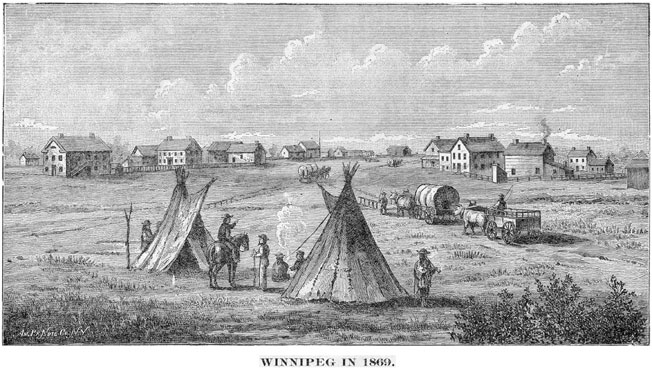
Winnipeg in 1869
The treatment of the Riel rebellion and the Fenian raid is omitted as these are rather provincial than civic events.
Page revised: 20 July 2010